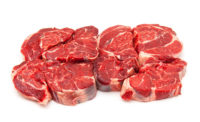Altered State
by Lynn Petrak
Special Projects Editor
Special Projects Editor
Meat and poultry processors face an extraordinary year fraught with unusual business pressures, but the prevailing wind blows with hope and promise.
Ask any meat and poultry expert about the current state of the industry, and you’re likely to get a cogent, if eyebrow-raising, response. Many involved in the processing and marketing of center-of-the-plate proteins concur that this has been a year like no other, at least in recent history.
Food analysts who track the industry attribute several factors as triggers of the non-traditional trends.
“It has been a weird year, with the imposition of quotas on U.S. chicken exports to Russia, incidents of ‘mad cow’ [disease], first in Canada and then the U.S., a doubling of soybean meal costs, a fifty-percent increase in corn costs, and cases of avian influenza in the U.S. and Asia. Then on the demand side of the equation, there is a consumer shift toward low-carb diets,” points out David C. Nelson, director of equity research for Credit Suisse First Boston, New York, NY. “What makes analyzing this industry quite tricky is that small changes in supply or demand have a very large effect on pricing — and we have had many big changes in supply and demand over the past year.”
William Chappell, vice president of equity research for Atlanta, GA-based Sun Trust Robinson Humphrey, cites similar unique factors at work. “The sheer magnitude of events affecting the industry this year is unlike what we have seen before, from mad cow to avian chicken flu to low-carb diets to you name it,” he says.
All the buzz aside, Chappell notes that many processors emerged from the situation in a strong position. “It’s been positive for all of those involved in the industry. Proteins have moved up the chain in terms of American consumers’ diets and prices have come along with it as well,” he points out.
Other industry sources also bemoan the ravaging effects of an economic climate with higher demand and higher prices, along with crisis flare-ups related to animal health and food-safety matters. The Washington, DC-based American Meat Institute (AMI), for its part, concentrated in recent months on fallout from the isolated bovine spongiform encephalopathy (BSE) cases in late 2003 and the ongoing topic of country of origin labeling (COOL) for meat products.
AMI, along with other industry groups including the National Meat Association, National Cattlemen’s Beef Association, National Pork Producers Council, and the Food Marketing Institute, among others, together petitioned the government seeking voluntary status for COOL rather than a regulatory mandate. “Country of Origin Labeling is another issue of great concern to us because it is nothing more than a massive, unfunded, and largely unwanted federal mandate that is going to force consumers to pay more for the food they eat,” remarks Patrick Boyle, president and chief executive officer of AMI. “That’s why we support a voluntary country-of-origin labeling program that is market driven, and therefore will allow consumers to decide whether or not they’re willing to pay more for enhanced origin labeling.”
While COOL has been on the agenda for many processors this year, BSE and avian flu spurred scores of crisis-management meetings.
“BSE will likely continue to be a major hot button issue because it has the potential to cause a lot of public anxiety and generate an immediate, negative impact on the stock market and cattle prices,” notes Boyle, adding that the collaboration within the industry helped to defuse any major backlash so far. “We’re very proud of the proactive and preventive steps the beef industry and the USDA have taken to combat the potential BSE threat, however.”
Lost trade hurts industry
Tied to BSE and the small outbreaks of avian flu impacting the U.S. poultry sector this year is processors’ continued concern with trade issues.
“In terms of our members, most of them are concerned about reopening trade with the more than thirty nations that closed their borders to most or all beef imports from the United States after a single case of BSE was discovered here last year. That lost trade is resulting in layoffs and downsizing for both producers and processors in the U.S.,” observes Boyle “And if the dispute is not resolved soon, it could eventually result in some plant closures.” The same situation confronted the chicken side of the industry, with some nations banning imports from America after outbreaks of avian flu.
Regulatory issue concerns
Meanwhile, other regulatory issues and their daily impact remain top-of-mind for meat and poultry companies, observes Steve Krut, executive director of the American Association of Meat Processors (AAMP), Elizabethtown, PA. “One of the major concerns has been the ever-changing inspection and regulatory arena,” he says. “There, though, I think we are starting to get an understanding at FSIS [the U.S. Food Safety and Inspection Service] that there may need to be some changes in what we inspect and the frequency of it — it seems at least in this stage in this administration, we are moving toward a more enlightened view.”
Another hot topic, adds Krut, relates to the “drastic” decrease in the number of small and regional processors with slaughter capacity. Regulations and restrictions on ‘downer” animals, he says, have proven costly for processors, especially when rendering companies won’t accept potential risk materials.
If those are a few of the main concerns facing the industry, the good news for processors is the uptick in consumption, which is affecting all protein categories to varying degrees. According to a recent survey by The Hoffman Estates, IL-based FreshLook Marketing Group, which tracks grocery scanner sales of fresh meat, dollar sales for beef, chicken, pork, turkey, and lamb all increased between 2003 and 2004.
Still, the outlook for the near future once again proves that this is an industry that is hard to pin down and predict. “The real question longer term is capacity — in a perfect world, everyone would maintain their supply levels at the same rate and all would benefit. But that’s not how the industry works,” Chappell concludes.




